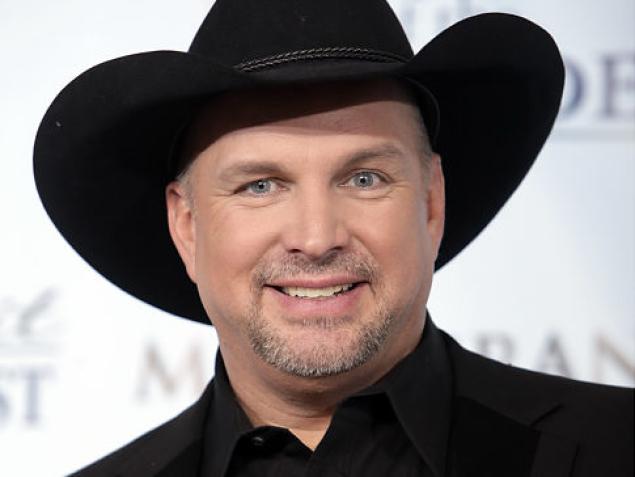Garth Brooks: The Comeback Of The Century So Far
February 5, 2015
By Scott Mervis
PITTSBURGH — There’s always a chance that Led Zeppelin will go back in the studio or Jim Morrison will return out of the blue, but we can probably go ahead and declare the return of Garth Brooks “the comeback of the century” so far.
The country star from Oklahoma, who turns 53 Saturday and opens a four-day run at Pittsburgh’s Consol Energy Center on Thursday, returned in November from his early, temporary retirement. In November, he released his first album in 13 years and it did …well, OK. With 140,000 in first-week sales, well below his usual figure, “Man Against Machine” failed to knock Taylor Swift from the top of the charts, and also fell behind the Foo Fighters and Pink Floyd to debut at No. 4.
But even in the competitive field of contemporary country, peopled with stadium players such as Kenny Chesney, Jason Aldean and Luke Bryan, the man can’t seem to play enough shows to satisfy demand. In July he announced that his first major tour since 2001 would begin in Chicago in September with a single show. On the morning of the ticket sales, they added three more Chicago shows. By the end of the day, they were up to 10 and ultimately 11.
For the Pittsburgh run, they started with three shows and once tickets went on sale, they doubled it to six over four days.
His popularity is attributed to him being a pioneer of pop-country, but he was certainly not the first to the dance. The ‘70s gave us such cross-overs as Glen Campbell, John Denver, Olivia Newton-John, Kenny Rogers and Dolly Parton. When John Travolta traded in the white suit for a cowboy hat and boots in “Urban Cowboy” — with a hit soundtrack featuring Anne Murray, the Charlie Daniels Band and the Eagles, among others — country took a further step away from “Hee-Haw.”
Hank Williams Jr. and Alabama came along to fill arenas in the ‘80s with a brand of amplified country-rock and slick arena production — in contrast to the New Traditionalists, who were more attuned to honky tonk (Dwight Yoakam, George Strait, Randy Travis).
Brooks grew up in a musical household, his mom being a country singer on Capitol in the ‘50s, so the old-time Southern music was in his DNA as he absorbed the new country sounds. He also loved the mainstream folk and rock of the ‘70s, from James Taylor to Springsteen to Kiss, laying the groundwork for his more explosive arena country style.
Upon making his name in the Oklahoma/Nashville club scenes, he signed to Capitol Nashville to release his 1989 debut. With most country stars, it takes a few albums to catch on. “Garth Brooks” was an instant success, charting two No. 1 country singles: “If Tomorrow Never Comes” and “The Dance.” His second album, 1990’s “No Fences,” sporting his signature song, “Friends in Low Places,” topped the country album chart for a stunning 23 weeks while also hitting No. 3 on pop.
Riding that success, 1991’s “Ropin’ the Wind” became the first album to debut atop both the country and pop charts. All told, his amazing commercial run between 1989 and 2001 produced six diamond-selling albums (10 million-plus) and established him as the second biggest-selling album artist of all-time, with sales of 135 million records (behind the Beatles at 178 million).
Although never much of a stud, he broke the country mold in concert, employing a headset microphone that allowed him to race around the stage and swing out over the crowd on a rope. Man of the people gone wild.
Pittsburgh country singer Dallas Marks, who launched his career 12 years ago, wasn’t sold on Brooks when he first heard his music. Then, he saw him live.
“It was country music with a rock ‘n’ roll show — pyrotechnics, huge lighting displays, stunts and constant motion — but with the genuineness and hard work ethic most country music fans can relate to.”
The Brooks experiment paved the way for a ‘90s country-pop takeover with a roster that included Shania Twain, LeAnn Rimes, Billy Ray Cyrus, Tim McGraw, Faith Hill, the Dixie Chicks and Brooks’ wife, Trisha Yearwood, who’s with him on the show.
John Wodarek, of Pittsburgh country band The Stickers, recalls a meeting in the office of a Nashville management company in the late ‘80s when he and his brothers were still teenagers.
“As we were in the waiting room, in comes this guy. Could not have been a nicer person. We were young and nervous, and I think he sensed that, and he started chatting us up. When our rep came out to get us, he introduces us to their newest client who he said is going to be huge: Garth Brooks. This is the guy we had been chatting with. We thought, ‘What a nice guy, I hope he gets there!’ About two years later he was the biggest thing since sliced bread.”
The Wodarek brothers saw something different in Garth Brooks that couldn’t help but influence their style.
“He took country music to another level and built the foundation I think of where country is today. He had that energy and edge that you saw in the over-the-top rock shows and created a modern country music sound that no one had heard before and didn’t see coming. It was exciting to watch him come to life.”
To others, he’s been the poster boy of the cartoon cowboy.
“To me, Garth’s legacy is about platinum records and shrewd, calculated marketing, not musical excellence,” says country historian Rich Kienzle, who writes the Get Rhythm blog for the Pittsburgh Post-Gazette. “The sound he created in the 1990s, rooted in ‘70s and ‘80s pop and rock, had no ties to earlier forms of country. Is country music better off because of Garth? I don’t think so. His music was all about formulas and, sadly, while today’s formulas are different, in 21st century Nashville, they still rule.”
Slim Forsythe, a country traditionalist who takes his cues from Hank Williams Sr., is a bit more forgiving. “I will just say that many of the artists we look back upon as traditional and even iconic now — Hank Williams, Ernest Tubb, Red Foley — were once looked upon as ‘innovators,’ ‘city slickers’ and even ‘sellouts.’ One man’s icon is another man’s ‘poser.’ “
Brooks brought the first phase of his career to an abrupt end in 2000, announcing he would retire until his youngest child turned 18. That birthday was celebrated last summer for Allie, the youngest of his three daughters.
“Garth is one of those artists you can see time and time again and enjoy each show more than the last. I think he is a great shot in the arm for country music right now,” Wodarek said.
Marks will take that a step further, saying, “People remember legends like Johnny Cash, Waylon, Willie and Hank for many reasons. Whether it be their music, their sound, their attitude or their mannerisms, it made people remember them. Like it or not, someday Garth Brooks will be considered a legend too.”








